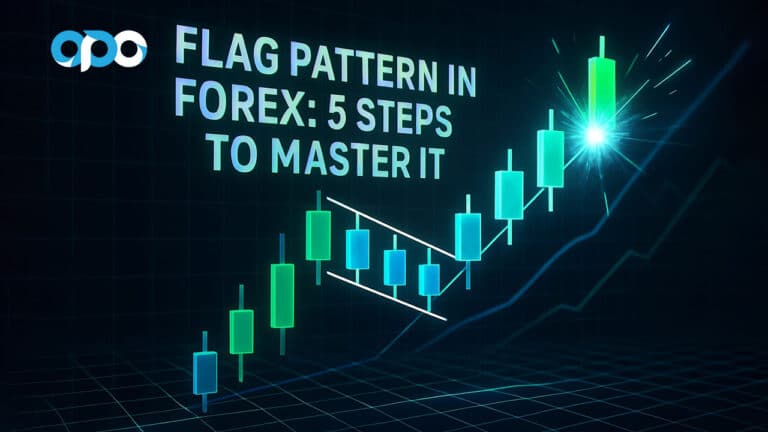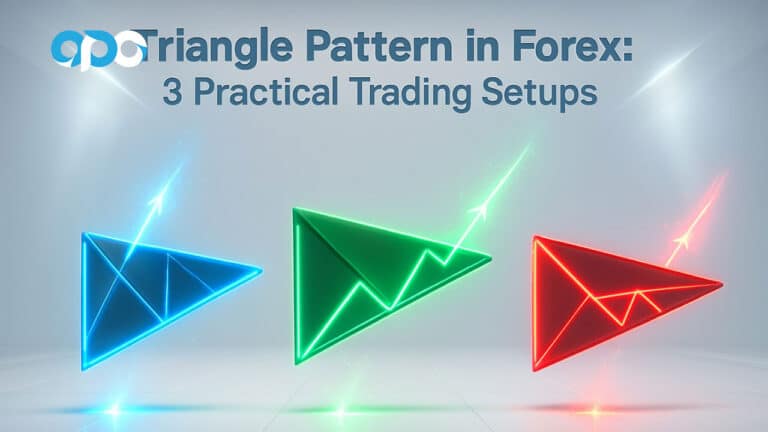Finding the best pairs for the Judas Swing is the crucial first step to leveraging this powerful ICT concept. The ideal pairs are not random; they are major currency pairs like EURUSD and GBPUSD, especially during the London session, due to their deep liquidity and predictable behavior. This allows for cleaner setups and more reliable trade execution. Success with this strategy requires a solid understanding of market mechanics and a reliable online forex broker to ensure precise entries. This guide will break down the absolute best pairs for the Judas Swing, explore their unique characteristics, and provide actionable playbooks for both the London and New York killzones.
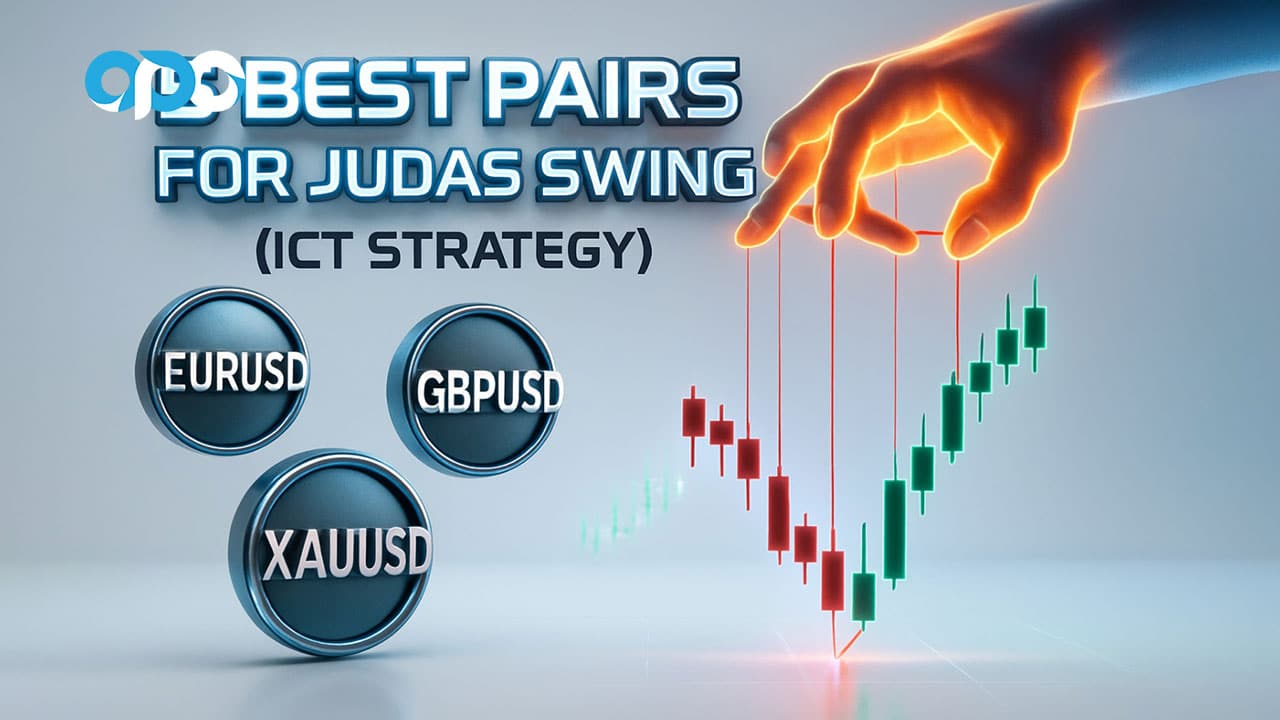
Quick Intro: The Judas Swing Explained
- False Move: The Judas Swing is fundamentally a false move engineered by smart money. It pushes against the daily or session bias to sweep liquidity from unsuspecting traders before aggressively reversing into the intended, real direction for the session.
- Prime Time Windows: The highest-probability windows for this setup cluster around major session opens. Key times are the London Killzone (2:00–5:00 AM EST) and the New York Killzone (7:00–9:00 AM EST). Many traders also observe the midnight–5:00 AM NY time as a classic development window for the initial leg of the move.
- What Makes the “Best Pair”: The “best pair” is a combination of three critical factors: perfect alignment with a session’s liquidity, a USD-centric major pair for predictable volume, and the clean, repetitive formation of ICT arrays like Fair Value Gaps (FVG) or Order Blocks (OB) during these specific windows.
- Top Candidates: For the London session Judas, focus primarily on EURUSD and GBPUSD. For the New York session, expand your watchlist to include XAUUSD and other US majors. Always validate your chosen pair through its liquidity behavior and structural confirmations like a Market Structure Shift (MSS).
Key Takeaways: Best Pairs for Judas Swing
| Session | Time (EST) | Best Pairs | Reason |
| London | 2:00 AM – 5:00 AM | EURUSD, GBPUSD | These pairs offer the deepest liquidity during the London open, leading to clean sweeps of the Asian session highs/lows and highly structured, textbook reversals. |
| New York | 7:00 AM – 9:00 AM | XAUUSD, USD Majors (e.g., USDJPY) | High USD-driven volatility and institutional order flow at the NY open create dramatic liquidity grabs and powerful displacement moves, perfect for NY Judas setups. |
| Midnight-London Development | 12:00 AM – 5:00 AM | EURUSD, GBPUSD | This window is often the “development” phase where the initial leg of the Judas Swing forms, setting up the main manipulation move right into the London open. |
What Defines a Best Pair for Judas Swing

Before you can effectively trade this setup, you must understand what makes certain pairs superior candidates. It’s not about picking the most volatile instrument; it’s about finding the most predictable one. The best pairs for the Judas Swing are those that offer a confluence of specific timing, deep liquidity, and clean, repeatable price structures. This alignment gives you, the trader, a statistical edge by filtering out noise and focusing on high-probability scenarios. From my experience, traders who fail with this strategy often do so because they trade the right pattern on the wrong pair or at the wrong time.
Best Times for Judas Swing
Timing is everything in trading, but for the Judas Swing, it is the foundational pillar upon which the entire strategy rests. The manipulation is specifically engineered to coincide with periods of maximum order flow and participant engagement. These are not random spikes; they are calculated moves.
- London Killzone (2:00–5:00 AM EST): This is the quintessential window for the classic Judas Swing. As London, the world’s largest financial center, opens, a massive influx of liquidity hits the market. Smart money uses this cover to engineer a sweep of the highs or lows of the preceding, quieter Asian session. For pairs like EURUSD and GBPUSD, this behavior is remarkably consistent. The moves are often clean, creating textbook patterns that are easier to identify and act on. For anyone serious about finding the best forex pairs for ICT Judas swing, the London session is the primary hunting ground.
- New York Killzone (7:00–9:00 AM EST): The NY session brings its own flavor of volatility, heavily influenced by US economic data and institutional flows. The Judas Swing here often manifests as a manipulation during the pre-market or right at the New York Stock Exchange open. This window is excellent for USD majors and commodities like Gold (XAUUSD). The manipulation might be a continuation of the London move or a complete reversal, often targeting key levels established earlier in the day. The energy of the NY open provides the necessary “displacement” that is a core component of a valid ICT setup.
- Midnight–5:00 AM EST (The “Development” Window): While the killzones are for execution, the hours leading up to the London open are for observation. Many traders, myself included, have noted that the initial leg of the Judas Swing often begins to form between midnight and 5:00 AM NY time. This period, often called the “London-NY” handover or consolidation phase, is where price is carefully positioned for the eventual liquidity grab. Understanding this development phase is crucial for establishing your daily bias and anticipating the direction of the impending sweep.
Liquidity and ICT Arrays
Once you’ve isolated the correct time window, the next step is to focus on pairs that provide the right ingredients for the setup: liquidity and structure. These two elements work in tandem. Liquidity provides the fuel for the move, while the structure provides the roadmap for execution.
- Exploitable Liquidity: The entire premise of the Judas Swing is the hunt for liquidity. This means you need pairs where pools of stop-loss orders predictably build up. During the London session, the most obvious pools are above the Asian session high and below the Asian session low. EURUSD and GBPUSD have immense order flow, making them the best pairs for the Judas Swing in this window because their behavior around these liquidity points is so reliable. For the NY session, liquidity pools form around the London session’s extremes, previous day’s highs/lows, and significant psychological price levels on pairs like XAUUSD.
- Clean ICT Arrays: A liquidity sweep is meaningless without a clean market structure to confirm the reversal. This is where Inner Circle Trader (ICT) concepts become indispensable. The best pairs are those that, after a sweep, consistently print clear and well-defined structural patterns. These include a Market Structure Shift (MSS) or Change of Character (CHoCH), a strong displacement candle showing commitment, and a subsequent Fair Value Gap (FVG) or Order Block (OB). These arrays are not just patterns; they are footprints of institutional activity, giving you a low-risk area to enter the market. If a pair sweeps liquidity but leaves behind a messy, ambiguous structure, it’s not a high-quality candidate, regardless of how big the move was.
Quick Judas Swing Setups
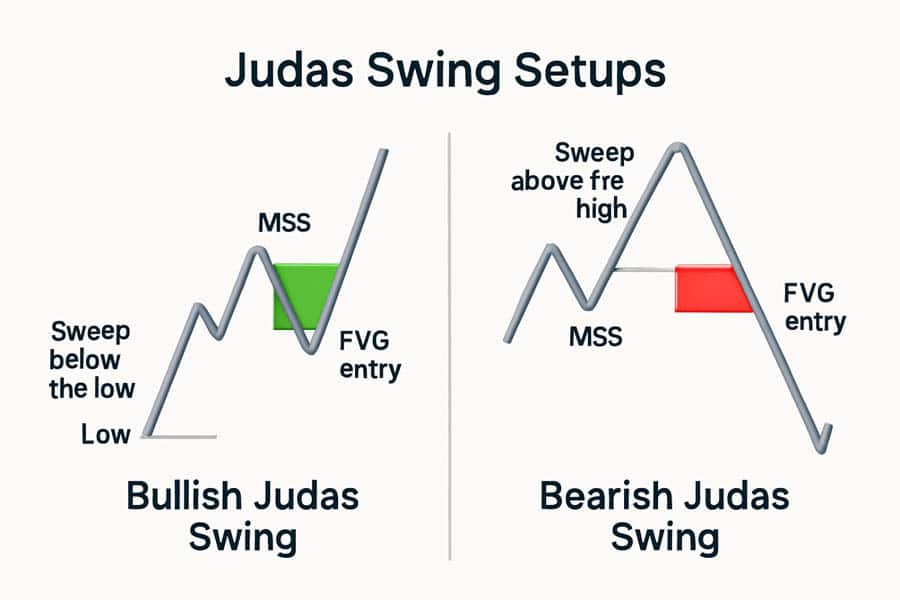
The beauty of the Judas Swing lies in its repeatable, logical sequence. While every trade is unique, the core structure remains the same. Understanding this template is key to identifying high-probability opportunities and avoiding false signals. The setup is a narrative of deception and reversal, and your job is to read the story as it unfolds on the chart. Below are the core definitions and requirements for both bullish and bearish scenarios.
The Core Idea and Confirmation
At its heart, the Judas Swing is a deceptive move away from the expected daily or session bias. Imagine the market has a clear bullish intention for the day. Smart money will first engineer a sharp drive downward to trigger the stop-loss orders of early long traders (sell-side liquidity) and trap breakout short-sellers. Once this liquidity is captured, the market shows its true hand with a powerful reversal.
The confirmation sequence is non-negotiable and provides the objective rules for entry:
- Liquidity Sweep: Price must clearly run above an old high or below an old low (e.g., Asian session high/low).
- Market Structure Shift (MSS): After the sweep, price must aggressively reverse and break the last swing point that led to the liquidity grab. This is your first signal that the manipulation is over and the real move is beginning.
- Displacement: The break of structure (the MSS) must occur with energy and momentum, often creating large-bodied candles and leaving behind an imbalance known as a Fair Value Gap (FVG).
- Entry Array: The entry is taken on a retracement back into a high-probability zone created by the displacement. This is typically a previously formed FVG or an Order Block (OB).
Bullish Judas Swing Template
A bullish Judas Swing aims to go long after smart money has engineered a false move down. The goal is to buy at a discount after the sell-side liquidity has been purged.
- Setup: The market’s higher-timeframe bias is bullish. During the killzone, price drives below the Asian session low or another key swing low, taking out sell-stops.
- Confirmation: After sweeping the low, price aggressively rallies and creates a Market Structure Shift (MSS) to the upside.
- Entry: You wait for price to retrace back down into a bullish FVG or a bullish Order Block created during the up-move. This is your low-risk entry point.
- Target: Your primary target should be the buy-side liquidity resting above a significant swing high, such as the Asian session high or the previous day’s high.
Bearish Judas Swing Template
Conversely, a bearish Judas Swing seeks to go short after a false move up has trapped early buyers. The goal is to sell at a premium after the buy-side liquidity has been run.
- Setup: The market’s higher-timeframe bias is bearish. During the killzone, price drives above the Asian session high or another key swing high, taking out buy-stops.
- Confirmation: After sweeping the high, price aggressively sells off and creates a Market Structure Shift (MSS) to the downside.
- Entry: You wait for price to retrace back up into a bearish FVG or a bearish Order Block created during the down-move.
- Target: Your primary target is the sell-side liquidity resting below a significant swing low, such as the Asian session low or the previous day’s low.
How to Choose Your Best Pair
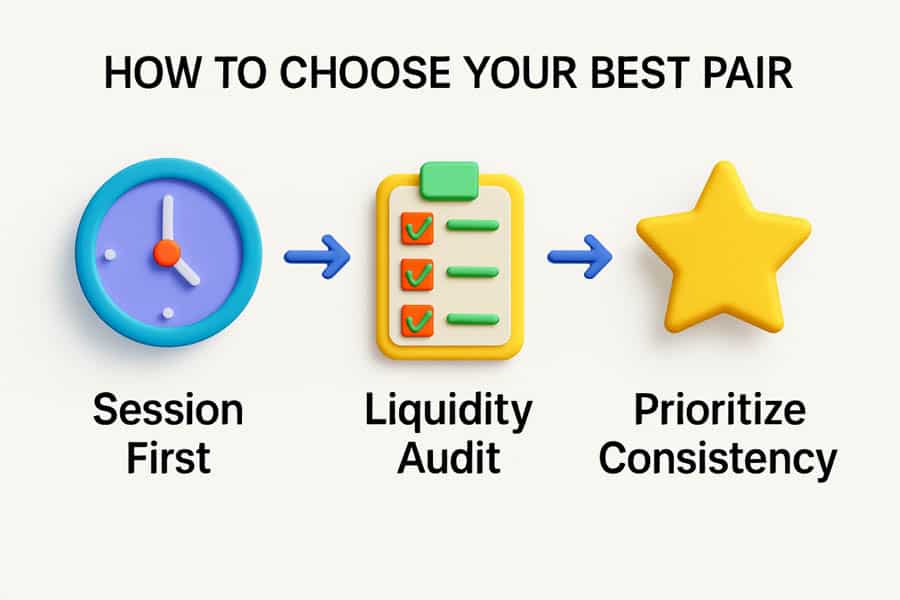
Identifying your personal best pairs for the Judas Swing is a process of aligning the market’s behavior with your trading schedule and risk tolerance. A pair that is perfect for a London-based trader may be unsuitable for someone trading the New York session. This selection process is not a one-time decision but a continuous audit of market conditions. In my own trading, I periodically review my chosen pairs to ensure they are still exhibiting the clean, predictable behavior required for this strategy. It’s an active process of refinement.
Session-First Selection
The most practical filter is your own availability. There is no point in trying to force trades on a pair during its low-volume hours. You must trade pairs whose primary liquidity window matches the time you can dedicate to the charts.
- For London Traders (or early birds in the US): If you are active during the 2:00–5:00 AM EST window, your focus should be squarely on EURUSD and GBPUSD. These are the best forex pairs for ICT Judas swing during this time, bar none. Their behavior is dictated by the European and UK institutional flows, leading to the high-quality setups we’ve discussed.
- For New York Traders: If your trading day starts with the New York session (7:00 AM EST onwards), your focus should shift to USD majors (like USDJPY, USDCAD) and, very importantly, XAUUSD (Gold). Gold is extremely sensitive to US dollar flows and often produces dramatic and profitable Judas Swings around the NY open.
Liquidity Behavior Audit
Once you’ve aligned your schedule with a session, the next step is to perform a “liquidity audit” on your candidate pairs. This involves manually backtesting and journaling. Go back on your charts for the last 30-60 days and ask these specific questions for your chosen killzone:
- How often is the Asian high or low swept?
- After the sweep, how often does a clear Market Structure Shift (MSS) occur?
- Following the MSS, does price leave behind a clean FVG or OB?
- How often does price return to this FVG/OB for a clean entry?
- Does the subsequent move have enough range to offer a reasonable risk-to-reward ratio?
Journaling the answers will quickly reveal which pairs behave most predictably. This data-driven approach removes emotion and guesswork from your pair selection.
Structure and Consistency
Finally, prioritize pairs that print clean structures over those that are merely volatile. Extreme volatility often leads to sloppy patterns, large wicks, and ambiguous signals, which are the enemies of a rules-based trader. The goal is not to catch the biggest move but the cleanest and most repeatable one. A pair that regularly prints identifiable FVGs and OBs after a displacement is far superior to one that has sporadic, wild spikes. This consistency is what allows for a systematic approach to trading, reducing ambiguity and improving your confidence in execution. This is a core reason why major pairs are considered the best pairs for the Judas Swing—their deep liquidity naturally creates more orderly price action.
Pair-by-Pair Playbooks
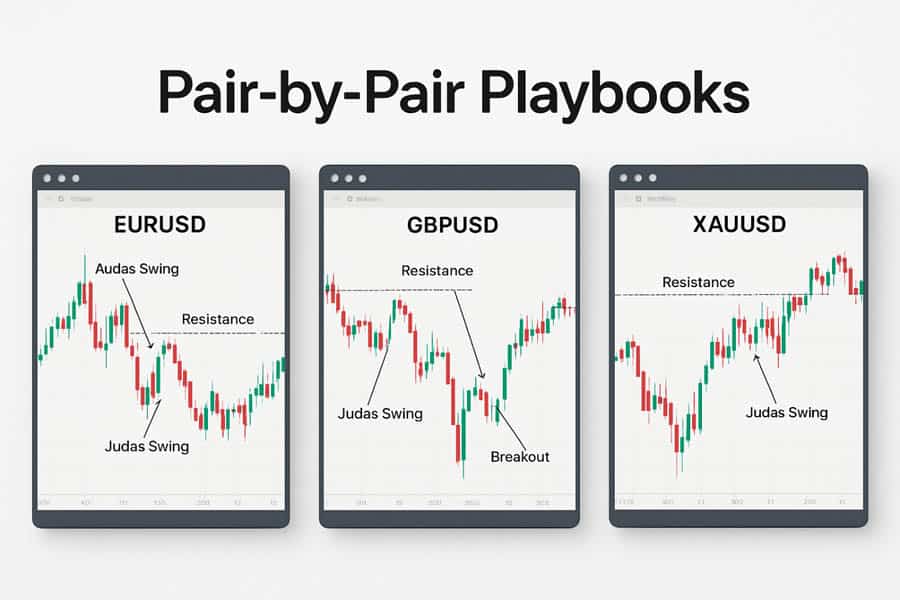
Theory is essential, but practical, experience-driven guidance is what translates knowledge into profit. This section provides a playbook for the top-tier pairs used for this strategy. These insights are based on countless hours of chart time and are designed to highlight the specific nuances of each instrument. Understanding these personalities is crucial for any trader looking for the best pairs for the Judas Swing.
EURUSD — London Judas Focus
Why it ranks high: EURUSD is the king of the London session. As the most traded currency pair in the world, it offers unparalleled liquidity, which translates into smoother, more structured price action. It consistently respects the Asian range, making the sweep of its highs or lows a very reliable event to build a trade idea around. Its behavior during the 2-3 AM EST window is often so clean that it feels like a textbook example playing out in real-time. This reliability makes it one of the absolute best forex pairs for ICT Judas swing traders, especially for those new to the concept.
Setups that work best: The classic EURUSD Judas Swing involves a sweep of the Asian high or low shortly after the London open (around 2-3 AM EST). Following the sweep, look for a swift Market Structure Shift (MSS) on the M15 or M5 timeframe. The key is the displacement that follows the MSS. This move should be powerful enough to create a clear Fair Value Gap (FVG). From my experience, the highest-probability entry is a patient wait for price to retrace and tap into this FVG, often within the “optimal trade entry” (OTE) 70.5% retracement level. The target is typically the opposing liquidity from the Asian range.
GBPUSD — Aggressive London Judas
Why it ranks high: If EURUSD is the king, GBPUSD (“Cable”) is the aggressive crown prince. It is highly reactive to London-based order flow and tends to move with more aggression and volatility than EURUSD. This can be a double-edged sword. On one hand, the inducement moves (the sweep) are often sharper, and the subsequent displacement is more powerful, providing very clear MSS and FVG entries. On the other hand, its volatility can lead to wider stops and more frequent fake-outs if you’re not patient. It’s an excellent candidate, but it demands more respect and confirmation.
Setups that work best: GBPUSD often performs its sweep of the Asian extremes slightly earlier or more aggressively than EURUSD. Look for the sweep followed by a clear Break of Structure (BOS) or MSS on the M5 chart. The key with Cable is to wait for the confirmation. Do not try to front-run the move. Once you have a confirmed MSS with displacement, look for a refined entry on a retracement to a clean Order Block or FVG. Because of its volatility, taking partial profits at clear intra-session highs or lows is a wise trade management strategy. This makes it a contender for the best pairs for the Judas Swing for more experienced traders.
XAUUSD — NY Judas Momentum
Why it ranks high: Gold is a different beast entirely and is the star player for the New York Judas Swing. Its price action is heavily sensitive to the US Dollar Index (DXY) and market risk sentiment, which are both at their peak during the NY open. The 7-9 AM EST window often produces dramatic sweeps and powerful, sustained reversals on Gold. When it moves, it does so with incredible momentum, offering excellent risk-to-reward potential in a short amount of time.
Setups that work best: The classic XAUUSD setup is a spike during the NY open (around 8:30 AM to 9:30 AM EST) that runs liquidity resting at round numbers ($2300, $2350) or the prior session’s extremes. This is often followed by a decisive displacement that leaves clean FVGs on the M1 to M5 charts. These lower-timeframe FVGs are prime entry points. Because Gold can move so quickly, entries and trade management must be precise. The targets are often clear prior highs/lows or other session liquidity magnets.
Nuances: You must use stricter risk management with Gold. Its whip-like moves demand confirmation, and your stop loss must be placed logically beyond the extreme of the Judas Swing wick. Rushing an entry on Gold is a recipe for disaster. Wait for the full confirmation sequence: sweep, MSS, and displacement.
USDJPY — NY and Overlap Precision
Why it ranks high: USDJPY offers a cleaner, more structured alternative to the raw volatility of Gold during the NY session. Its price action is heavily influenced by US Treasury yields and monetary policy, which leads to orderly, trend-driven moves during the NY killzone. What makes it one of the best pairs for the Judas Swing is how cleanly it reacts to Order Blocks after a Market Structure Shift. It often provides very precise, low-drawdown entries for patient traders.
Setups that work best: Look for a sweep above or below the London session extremes as New York comes online. Following the sweep, watch for a clear MSS on a lower timeframe (M5 or M15). The highest-probability entry on USDJPY is often a retracement to the OTE level that coincides with a well-defined FVG or Order Block. The subsequent move is typically a smooth continuation toward the next major liquidity pool.
Nuances: Pay close attention to key psychological round levels (e.g., 150.00, 151.00) and scheduled US news events, as these often act as magnets for liquidity sweeps in USDJPY. Its methodical nature requires patience; it may not have the explosive moves of Gold, but its precision is a significant edge.
Pre-Trade Validation Checklist
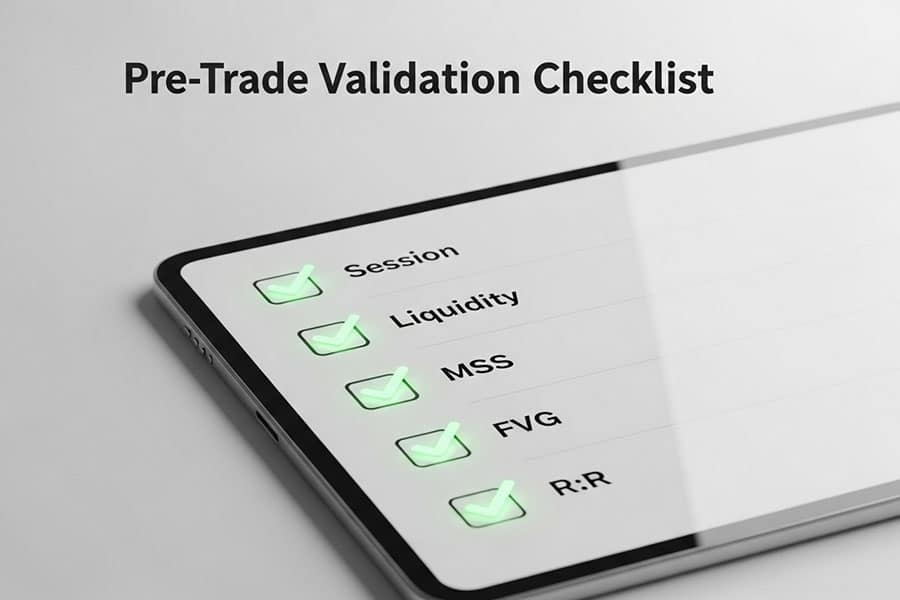
Discipline is the bridge between trading goals and accomplishment. A pre-trade checklist transforms trading from a gambling exercise into a professional, process-driven business. Before you risk a single dollar on a Judas Swing setup, you must be able to tick every single one of these boxes. This checklist is your final shield against impulsive decisions and low-probability trades. I never take a trade without running through this mental (or physical) list. This rigor is what separates consistently profitable traders from the crowd, especially when dealing with the nuance of finding the best pairs for the Judas Swing.
- Session Alignment: Is it the correct killzone for your chosen pair? For EUR/GBP, it must be the London Killzone (2-5 AM EST). For USD majors or XAUUSD, it must be the New York Killzone (7-9 AM EST). If the time is wrong, the trade is off.
- Liquidity Map: Have you clearly marked the key liquidity levels on your chart? This includes the Asian session high and low, the previous day’s high and low (PDH/PDL), and any obvious equal highs or lows (EQH/EQL). You cannot trade a liquidity sweep if you don’t know where the liquidity is.
- Manipulation Confirmation: Has a false break into one of these liquidity pools actually occurred? You must witness the sweep. Don’t anticipate it. Wait for price to clearly run the stops above a high or below a low.
- Structure Shift (MSS): This is the most critical confirmation. After the sweep, have you waited for a clear Market Structure Shift (or CHoCH) in your intended direction? The break must be decisive and occur with energetic displacement candles. No MSS, no trade.
- Entry Array: Have you identified a valid entry array? Is there a clean Fair Value Gap (FVG) or a high-confluence Order Block (OB) to enter on? Is this array located in the correct context (i.e., in a discount for longs, or a premium for shorts)? Better yet, does it align with an Optimal Trade Entry (OTE) zone?
- Targets and Risk: Is there a clear and logical opposing liquidity pool to target for your take-profit? Is your stop loss placed logically beyond the extreme wick of the Judas Swing manipulation? Is the potential reward at least twice your risk? If the risk-to-reward is poor, the trade is not worth taking.
Common Mistakes to Avoid
Learning what not to do is just as important as learning what to do. The Judas Swing is a powerful concept, but it’s also filled with traps for the undisciplined trader. Over the years, I’ve seen aspiring ICT traders make the same handful of costly mistakes over and over. Avoiding these common pitfalls will dramatically accelerate your learning curve and protect your capital. Recognizing these errors is a sign of a maturing trader who understands that finding the best forex pairs for ICT Judas swing is only half the battle.
- Trading Outside the Killzones: The statistical edge of the Judas Swing is heavily concentrated in the London and New York killzones. Trying to find a Judas Swing during the quiet Asian session or in the middle of the afternoon is a low-probability endeavor. The liquidity is not present to engineer the clean manipulations required. Stick to the designated hours.
- Entering Before the Market Structure Shift: This is the most common and costly mistake. Eager traders see the sweep and immediately jump in, trying to catch the exact top or bottom. This is guessing, not trading. You must wait for the market to confirm the reversal with a clear MSS and displacement. Entering before confirmation is how you become the liquidity, not how you profit from it.
- Ignoring Premium/Discount Context: ICT concepts are built on the logic of buying in a discount (the lower half of a range) and selling in a premium (the upper half). If you are looking for a long entry, you must wait for price to retrace to an FVG or OB that is in a discount. Taking an entry in a premium area significantly hurts your risk-to-reward ratio and puts you on the wrong side of the market’s algorithm.
- Treating Every Sweep as a Judas Swing: Not every run on liquidity is a Judas Swing. A sweep could simply be a stop run before a continuation of the trend. The difference lies in the context. A true Judas Swing aligns with a higher-timeframe bias and is confirmed by the full sequence (sweep -> MSS -> displacement). Without that confluence, it’s just a random price spike.
Opofinance: Your Regulated Trading Partner
To effectively trade sophisticated strategies like the Judas Swing, you need a broker that provides precision, reliability, and advanced tools. Opofinance, regulated by ASIC, is built for the modern trader.
- Advanced Trading Platforms: Choose from industry-leading platforms including MT4, MT5, cTrader, and the proprietary OpoTrade app.
- Innovative AI Tools: Gain a competitive edge with an AI Market Analyzer, an AI Coach to refine your strategy, and instant AI Support.
- Flexible Trading Options: Explore opportunities in Social Trading and Prop Trading directly through the platform.
- Secure & Flexible Transactions: Enjoy peace of mind with safe, convenient deposits and withdrawals, including crypto payments with zero fees.
Elevate your trading experience and execute with confidence. Start trading with Opofinance today!
Conclusion
Mastering the Judas Swing begins with a disciplined approach to pair selection. The best pairs for the Judas Swing are not a matter of opinion but a function of session timing, liquidity, and structural clarity. By focusing on EURUSD and GBPUSD during the London killzone, and XAUUSD or other USD majors during the New York session, you align yourself with the market’s most predictable rhythms. Remember to use the pre-trade checklist rigorously and learn from common mistakes. This strategic focus is what will ultimately lead to consistent results.
Can I trade the Judas Swing on any timeframe?
While the pattern can appear on various timeframes, it is most reliable when you establish your bias on a higher timeframe (like H1 or H4) and look for the entry sequence (sweep, MSS, FVG) on lower timeframes like M15 or M5 during the key killzones.
Is the Asian Range essential for every Judas Swing?
For the classic London Judas Swing, the Asian range is the most critical liquidity pool. For the New York session, the liquidity target might be the London session’s high/low or a previous day’s high/low instead.
What if the FVG is too large after the displacement?
If a Fair Value Gap is very large, it can lead to a poor risk-to-reward ratio. In these cases, you can look for a more refined entry, such as waiting for price to retrace to the 50% level (consequent encroachment) of the FVG or looking for a smaller FVG on an even lower timeframe within the larger one.
How does the US Dollar Index (DXY) help?
The DXY is crucial for context. If you see a bullish Judas Swing setup on EURUSD (a sweep of lows followed by an MSS up), you should ideally see a corresponding bearish pattern on the DXY (a sweep of highs followed by an MSS down). This intermarket correlation adds immense confirmation to your trade idea.
Can this strategy be automated?
Automating the Judas Swing is extremely difficult due to its discretionary nature. Key elements like identifying the correct liquidity pool, confirming a “clean” MSS, and assessing the quality of the displacement require a trader’s discerning eye. It is best traded manually.
References:






